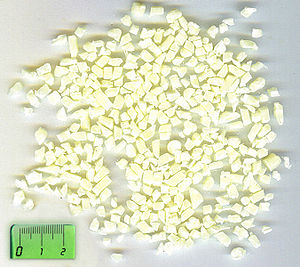User:Mbaboy/InventablesTest
| This is not a Wikipedia article: It is an individual user's work-in-progress page, and may be incomplete and/or unreliable. For guidance on developing this draft, see Wikipedia:So you made a userspace draft. Find sources: Google (books · news · scholar · free images · WP refs) · FENS · JSTOR · TWL |
New article name is

| |
| Identifiers | |
|---|---|
| Properties | |
| (C8H8·C4H6·C3H3N)n | |
| Related compounds | |
Except where otherwise noted, data are given for materials in their standard state (at 25 °C [77 °F], 100 kPa).
| |


Acrylonitrile butadiene styrene (ABS) (chemical formula (C8H8)x· (C4H6)y·(C3H3N)z) is a common thermoplastic used to make light, rigid, molded products such as piping (for example plastic pressure pipe systems), musical instruments (most notably recorders and plastic clarinets), golf club heads (used for its good shock absorbance), automotive body parts, wheel covers, enclosures, protective headgear, buffer edging for furniture and joinery panels, Thule boxes, airsoft BBs, kitchen appliances (such as juicers), and toys, including Lego bricks.[1] Its melting point is approximately 221°F (105°C) [2]. ABS plastic ground down to an average diameter of less than 1 micrometer is used as the colorant in some tattoo inks. Tattoo inks that use ABS are extremely vivid. This vividness is the most obvious indicator that the ink contains ABS, as tattoo inks rarely list their ingredients.[3]
It is a copolymer made by polymerizing styrene and acrylonitrile in the presence of polybutadiene. The proportions can vary from 15 to 35% acrylonitrile, 5 to 30% butadiene and 40 to 60% styrene. The result is a long chain of polybutadiene criss-crossed with shorter chains of poly(styrene-co-acrylonitrile). The nitrile groups from neighboring chains, being polar, attract each other and bind the chains together, making ABS stronger than pure polystyrene. The styrene gives the plastic a shiny, impervious surface. The butadiene, a rubbery substance, provides resilience even at low temperatures. For the majority of applications, ABS can be used between −25 and 60 °C as its mechanical properties vary with temperature. The properties are created by rubber toughening, where fine particles of elastomer are distributed throughout the rigid matrix.
Production of 1 kg of ABS requires the equivalent of about 2 kg of oil for raw materials and energy. It can also be recycled.[4]

Properties
[edit]ABS is derived from acrylonitrile, butadiene, and styrene. Acrylonitrile is a synthetic monomer produced from propylene and ammonia; butadiene is a petroleum hydrocarbon obtained from the C4 fraction of steam cracking; styrene monomer is made by dehydrogenation of ethyl benzene - a hydrocarbon obtained in the reaction of ethylene and benzene.
The advantage of ABS is that this material combines the strength and rigidity of the acrylonitrile and styrene polymers with the toughness of the polybutadiene rubber. The most important mechanical properties of ABS are impact resistance and toughness. A variety of modifications can be made to improve impact resistance, toughness, and heat resistance. The impact resistance can be amplified by increasing the proportions of polybutadiene in relation to styrene and also acrylonitrile although this causes changes in other properties. Impact resistance does not fall off rapidly at lower temperatures. Stability under load is excellent with limited loads. Thus, changing the proportions of its components ABS can be prepared in different grades. Two major categories could be ABS for extrusion and ABS for injection moulding, then high and medium impact resistance. Generally ABS would have useful characteristics within a temperature range from -40 to 100 °C.
The final properties will be influenced to some extent by the conditions under which the material is processed to the final product; for example, molding at a high temperature improves the gloss and heat resistance of the product whereas the highest impact resistance and strength are obtained by molding at low temperature. Fibers (usually glass fibers) and additives can be mixed in the resin pellets to make the final product strong and raise the operating range to as high as 80°C. Pigments can also be added as the raw material original color is translucent ivory to white. The aging characteristics of the polymers are largely influenced by the polybutadiene content, and it is normal to include antioxidants in the composition. Other factors include exposure to ultraviolet radiation, for which additives are also available to protect against.
Even though ABS plastics are used largely for mechanical purposes, they also have electrical properties that are fairly constant over a wide range of frequencies. These properties are little affected by temperature and atmospheric humidity in the acceptable operating range of temperatures.[5]
ABS polymers are resistant to aqueous acids, alkalis, concentrated hydrochloric and phosphoric acids, alcohols and animal, vegetable and mineral oils, but they are swollen by glacial acetic acid, carbon tetrachloride and aromatic hydrocarbons and are attacked by concentrated sulfuric and nitric acids. They are soluble in esters, ketones and ethylene dichloride.
While the cost of producing ABS is roughly twice the cost of producing polystyrene, ABS is considered superior for its hardness, gloss, toughness, and electrical insulation properties. It is degraded (dissolved) when exposed to acetone.[6] ABS is flammable when it is exposed to high temperatures, such as a wood fire. It will "boil", then burst spectacularly into intense, hot flames.
References
[edit]- ^ ABS - acrylonitrile butadiene styrene On Designsite.dk, lists applications. Retrieved 27 October 2006.
- ^ - Plastic Properties of Acrylonitrile Butadiene Styrene (ABS) Small table of ABS properties towards the bottom. Retrieved 1:50 AM 7 May 2010
- ^ Biology News: Is tattoo ink safe?
- ^ Plastics Recycling
- ^ Harper C.A., Handbook of plastic and elastomers, McGraw-Hill, New York, 1975, pp. 1-3,1-62, 2-42, 3-1
- ^ Vintage Computing and Gaming | Archive » Why Super Nintendos Lose Their Color: Plastic Discoloration in Classic Machines
External links
[edit]Category:Plastics Category:Copolymers Category:Thermoplastics
External links
[edit]



